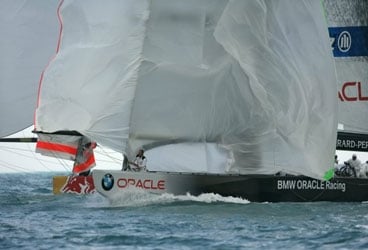
FBMainstreamSt
Many people will think that I’m looking a gift horse in the mouth when I complain about the New York Times’ coverage of Tuesday’s opening race of Louis Vuitton Act 13. The Times, after all, has been one of the few national dailies to cover the America’s Cup, and has regularly reported from the Acts in Europe. Bad press, we should say as we kowtow at the altar of general-interest media, is better than no press.But sailing should receive more respect from the Times than it was afforded on Wednesday. The headline on the story by Doreen Carvajal read “Contender in Money Race Wins Cup Warm-Up Race.” She then wrote primarily about the great disparity between the rich and poor teams in Valencia and how money will be the primary factor in deciding who wins the Louis Vuitton Cup.And that makes the America’s Cup different from how many other professional sports? Money is always a factor, that’s why they’re called professional sports. The more you have-the more you can pay-the better chance you have of winning. You’d think that the Times would appreciate this fact, being the hometown paper of the New York Yankees, a team that has, for the last decade, defined what sort of consistent success can be crafted with a blank check. Ironically enough, the day before, the same Yankees opened their season with a win over the Tampa Bay Devil Rays. Yet the story about the Yankees 9-5 win never once mentioned that the Devil Rays’ $30 million payroll is less than what the Yankees are paying its two top players, Alex Rodriguez and Derek Jeter, and one-sixth the Yankees total payroll of $200 million. Instead Yankees beat reporter Tyler Kepner preferred to focus on other topics, like how the Yankees overcame a series of errors, how the much-maligned Rodriguez came through in the clutch, and how the team honored the memory of former pitcher Cory Lidle, who died in a plane crash during the offseason.Imagine if Carvajal had used a similar approach when reporting on the first race of Act 13. She could’ve talked about how the defender Alinghi was over early-a rare mistake for a polished franchise-but stormed back to finish fourth. How +39 Challenge, the poorest of the poor syndicates in Valencia, nailed the first beat, lead the fleet for 3.5 of the 4 legs, and then lost everything to finish 10th. How Team Shosholoza, which has made remarkable progress for a first-time syndicate, finished second after a stirring comeback. Or how BMW Oracle Racing showed some serious chops with a jibe peel in a close situation on the final run and then, flying a better spinnaker, jetted away from rival Alinghi, turning a two-boatlength lead into a 3:30 winning advantage in quite short order. There were stories aplenty on Day 1 of Act 13, yet the Times missed nearly all of them to take a cheap shot at sailing’s rich history. Rich as in money, that is. Unfortunately, it won’t be the last. The Times is likely to walk this well-tread path again, and we should brace ourselves for the onslaught of stories in other general-interest media, from national newspapers to glossy magazines, that will focus on the Cup’s idiosyncrasies, the proverbial low-hanging fruit. We’re sure to hear plenty about the gross budgets of the Cup, the reporters ignorantly throwing out the totals without bothering to inform the reader that the budgets are for a four-year campaign, not an annual effort. Or, to play another angle, about how much money is spent on vehicles that never go faster than 15 mph. Another popular topic will be the Walter Mitty-esque involvement of billionaires Ernesto Bertarelli and Larry Ellison, each sailing on his respective boat. Finally, they’ll write about the lengths to which each team goes to protect its own technological assets while trying to steal those of other teams.I’m not denying these are part of the America’s Cup. They certainly are. But there are plenty of other storylines that don’t prey on the preconceived notions that sailing is a sport for the idle rich or that the outcome is determined solely by the amount of money spent. In fact, while I agree with Ms. Carvajal that the America’s Cup is very much a design race, I’m quite disappointed she failed to mention that only once in the last 25 years has the largest budget translated into the fastest design and, consequently, victory. The poorest team may never win, but the richest team rarely does.We’re about to embark upon a remarkable three months of sailing. The odds are good that the team left standing at the end of the Louis Vuitton Cup will be one that spent a lot of money. But the odds are even better that the road there won’t be easy, that there will be plenty of upsets, drama, and excitement, that we’ll see some remarkable performances by teams that in the past would’ve struggled to stay within sight of the big dogs in most races, and that the final result will be based more on how well a team spent its money than how much it spent.In short, it will be a spectacle to behold. It would be nice if the non-sailing press gave the public a reason to tune in, rather than reinforcing their ill-informed notions of why they should tune out.









